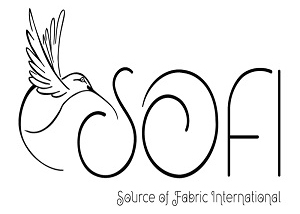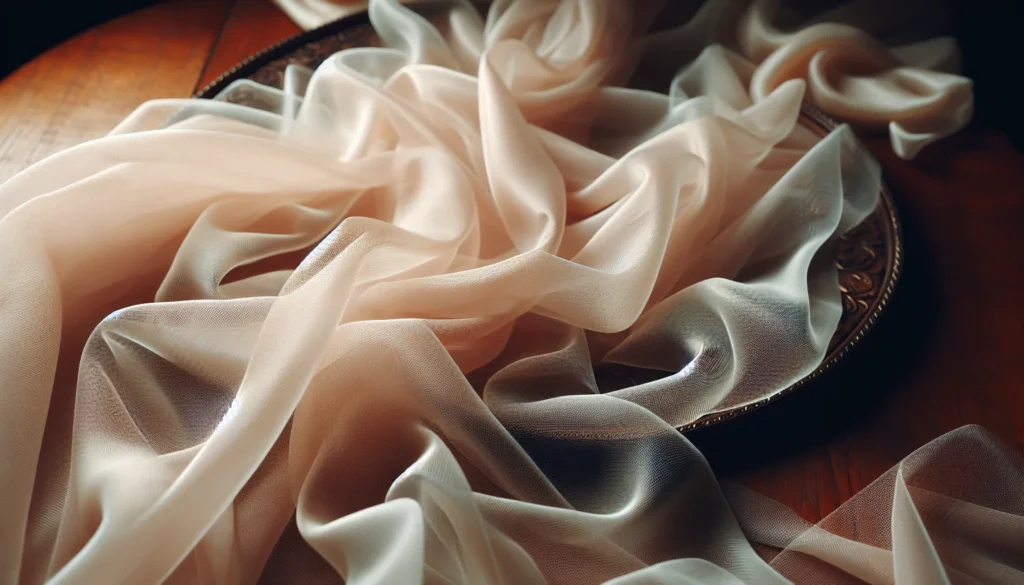Silk organza is a fabric that effortlessly combines elegance and versatility, making it a favorite among fashion designers and DIY enthusiasts alike. This lightweight, sheer textile adds a touch of sophistication to any project, from evening gowns to home decor. If you’ve ever admired the delicate draping of a gown or the ethereal quality of a veil, chances are silk organza played a key role.
What sets silk organza apart is its unique structure. Made from silk fibers, it boasts a crisp finish and a subtle sheen that elevates any design. Whether you’re looking to create voluminous skirts or delicate overlays, this fabric offers the perfect balance of support and softness. Dive into the world of silk organza and discover how it can transform your creative endeavors while adding an air of luxury to your wardrobe or living space.
Understanding Fabric Silk Organza
Silk organza is a notable fabric used in various fashion and decor projects. This lightweight and sheer material is made from silk fibers, providing a unique structure that appeals to many creators.
What Is Silk Organza?
Silk organza is a smooth, thin fabric often used in apparel and home decorations. Originally crafted in Asia, it consists of finely woven silk fibers. This fabric displays a crisp finish and boasts a slight sheen, contributing to its popularity. Its lightweight nature allows for fluid draping, making it an excellent choice for garments such as evening gowns, bridal wear, and overlays. Silk organza can also blend beautifully with other fabrics, adding dimension and texture to various creations.
Characteristics of Silk Organza
Silk organza presents several key characteristics that set it apart.
- Sheerness: Silk organza is notably transparent, allowing for creative layering in fashion items and decorations.
- Crispness: The fabric maintains a structured shape, giving volume to skirts, sleeves, and floral arrangements.
- Glossiness: The soft sheen of silk organza enhances its visual appeal, making garments look luxurious.
- Durability: Despite its delicate appearance, silk organza possesses resilience, enduring wear while maintaining its beauty.
- Breathability: The lightweight nature of silk organza ensures comfort, making it suitable for warm climates and layered outfits.
These characteristics render silk organza a sought-after option for creative endeavors in fashion and home design.
Common Uses of Silk Organza
Silk organza finds application in various areas. Here are some common uses:
- Evening Wear: Designers favor silk organza for evening gowns, creating flowing silhouettes and dramatic layers.
- Bridal Accessories: This fabric enhances wedding dresses, veils, and sashes, adding a touch of sophistication to bridal ensembles.
- Home Decor: Drapes and curtains made from silk organza provide an ethereal quality, filtering light while maintaining privacy.
- Craft Projects: DIY enthusiasts use silk organza for creating flowers, hair accessories, and embellishments for clothing.
- Costume Design: The fabric is popular in theatrical costumes, allowing for bold designs without adding bulk.
Silk organza’s versatility makes it ideal for both professional and personal creative projects.
Choosing Fabric Silk Organza
Selecting the right silk organza involves understanding various aspects of this fabric to enhance your project.
Types of Silk Organza Available
Different types of silk organza exist, each offering unique qualities. Organza can vary in fiber content, including 100% silk and silk blends with synthetic fibers. Pure silk organza provides a luxurious feel and sheen, ideal for high-end garments and decor. Silk blends, such as silk-polyester combinations, offer added durability and often come at a lower price point. Additionally, there are structured options like stiffer organza, which holds shape well, and softer varieties that drape beautifully. Assessing these types helps ensure you select the best option for your intended use.
Choosing the Right Weight for Your Project
Weight plays a crucial role in the effectiveness of silk organza for different applications. Light-weight organza works well for delicate overlays and soft ruffles, while medium-weight options function nicely for structured pieces like collars or skirts. Heavier organza can be suitable for evening wear, providing an eye-catching volume. Weighing your project requirements against the fabric’s weight can guide you in creating the desired look and feel. Avoiding overly heavy choices for lightweight designs will prevent bulkiness, ensuring a flattering silhouette.
Color and Pattern Options
Silk organza offers a variety of color and pattern choices. Solid colors range from soft pastels to vibrant hues, making it easy to find a shade that matches your vision. Additionally, printed organza features patterns such as florals, geometric shapes, or intricate designs, adding interest to your project. Evaluating the color scheme of your overall design can influence your choice. For example, using a patterned organza as an overlay on a solid base can create a stunning effect. Exploring these options ensures a harmonious look in your final creation.
Preparing to Work with Fabric Silk Organza
Getting ready to work with fabric silk organza requires specific materials and tools to ensure successful projects. Attention to detail simplifies the process and enhances your final results.
Materials Needed
- Silk Organza Fabric: Choose the appropriate type based on project needs. Options include pure silk organza or silk blends with differing weights.
- Thread: Select thread that matches the fabric color. Use silk thread or polyester thread for better durability and to maintain fabric integrity.
- Interfacing: Consider lightweight interfacing for added structure, especially if working with garments that require support.
- Pins or Clips: Use glass-head pins or fabric clips to secure pieces without damaging the delicate fabric.
- Scissors: Invest in sharp fabric scissors for precise cutting. Avoid using paper scissors to maintain blade sharpness.
Tools Required
- Sewing Machine: Utilize a sewing machine with a straight stitch function. A machine with adjustable stitch length accommodates different fabric weights.
- Needles: Use a size 60/8 or 70/10 needle specifically designed for fine fabrics to avoid snags.
- Iron: Employ an iron with a steam function. A pressing cloth protects the fabric from direct heat.
- Cutting Mat: Protect surfaces with a cutting mat to provide a safe cutting area.
- Ruler: A clear ruler assists in measuring and cutting straight lines accurately.
Pre-Washing and Ironing Tips
Pre-washing silk organza eliminates excess dye and minimizes fabric shrinkage. Wash the fabric in cool water using a gentle detergent to maintain quality. Air-drying is ideal to avoid heat damage. When ready to iron, set the iron to the lowest heat setting. Place a pressing cloth over the silk organza to prevent scorching. Lightly steam the fabric to remove wrinkles. Always test your iron on a scrap piece before proceeding with the main fabric. Following these steps helps achieve a clean finish for your project.
Sewing with Fabric Silk Organza
Sewing with silk organza requires specific techniques to achieve the best results. Understanding these methods enhances your experience and the quality of your finished projects.
Techniques for Cutting Silk Organza
Cutting silk organza involves careful handling to maintain its quality and shape.
- Use Sharp Scissors: Invest in high-quality fabric scissors for clean cuts. Dull scissors risk fraying the edges.
- Stabilize the Fabric: Place the fabric on a flat surface to prevent shifting. Use pattern weights or pins to hold the fabric in place.
- Cut with Precision: Follow your pattern lines closely. Take your time to avoid unnecessary errors that lead to fabric waste.
- Cut One Layer at a Time: Cutting multiple layers can cause uneven edges. Always cut one layer for accuracy.
- Consider a Rotary Cutter: If you are comfortable, rotary cutters work well on silk organza for straight cuts.
These strategies ensure clean edges and prevent damage during the cutting process.
Best Stitching Methods for Silk Organza
Choosing the right stitching methods significantly affects your project’s outcome.
- Use a Fine Needle: Opt for a size 60/8 or 70/10 needle, which handles delicate fabrics more gently.
- Select the Right Thread: Use fine polyester thread that matches the fabric’s weight. It provides durability without bulk.
- Stitch Length of 1.5 mm: Set your machine to a shorter stitch length. This secures the seams while preventing puckering.
- Sew with a Straight Stitch: A straight stitch typically suits silk organza best. It provides even tension across the fabric.
- Sew on a Lower Tension Setting: Adjusting the machine’s tension to a lower setting helps avoid puckering and maintains the fabric’s drape.
These stitching methods contribute to a polished final product, allowing the beauty of silk organza to shine through.
Seam Finishing Techniques
Finishing seams properly protects the edges of your silk organza.
- French Seams: For delicate projects, consider using French seams. They encase raw edges and prevent fraying.
- Zigzag Stitch: A zigzag stitch can help finish raw edges. Set your machine for a narrow setting and stitch along the edge.
- Bias Tape: Using bias tape to bind the edges provides a neat finish and adds design interest.
- Overlock Stitch: If you have an overlock machine, use it for a professional edge finish. It trims and secures raw edges in one step.
- Hand Stitching: For small areas or delicate finishes, hand stitching may offer the greatest control and precision.
Employing these techniques ensures seams remain intact while enhancing the aesthetic appeal of your final creation.
Alternatives to Fabric Silk Organza
Consider various fabrics that offer similar qualities to silk organza. These alternatives provide options for different projects while maintaining a lightweight and sheer appeal.
Other Sheer Fabrics
- Chiffon
- Chiffon consists of lightweight polyester or silk fibers. It has a delicate texture and flows gracefully. Chiffon often appears in eveningwear and bridal dresses due to its sheer properties.
- Tulle
- Tulle fabric features a net-like structure, usually made from nylon or silk. Tulle adds volume and structure. Commonly used in bridal veils and petticoats, tulle provides a whimsical look to designs.
- Georgette
- Georgette consists of twisted yarns that create a slightly crinkled surface texture. It is softer and less sheer than silk organza, making it suitable for flowing gowns and blouses.
- Voile
- Voile is a lightweight cotton or polyester fabric with a soft finish. It is sheer enough for curtains or dresses. Voile’s breathability makes it ideal for warm-weather garments.
- Organza
- Organza is similar to silk organza but typically made from synthetic fibers like nylon. It maintains a crisp hold and sheer finish. Organza often appears in overlays for dresses and other formal wear.
Pros and Cons of Alternatives
Pros:
- Cost-Effective: Fabrics like chiffon and tulle usually cost less than silk organza, providing budget-friendly options.
- Variety: Numerous sheer fabrics offer different textures and weights. Choices cater to specific design needs.
- Durability: Synthetic alternatives like organza can be more durable than silk. These fabrics withstand wear and tear better.
Cons:
- Lesser Sheen: Some alternatives may lack the luxurious sheen of silk organza. This affects the overall visual appeal.
- Weight Variations: Heavier alternatives may not drape as fluidly as silk organza, impacting the design’s flow.
- Higher Maintenance: Some fabrics require specific care instructions. For instance, chiffon may snag more easily compared to silk organza.
Choosing an alternative requires weighing these factors against your project goals and desired outcomes.
Troubleshooting Common Issues
Silk organza is a beautiful fabric, but sometimes issues arise during your projects. Here are solutions to common problems you might encounter.
Dealing with Slipping and Shifting
Use fabric weights to hold down silk organza while cutting. These weights prevent movement and ensure precise shapes. Pinning firmly also helps; use silk pins that won’t leave marks on the fabric’s surface. Cut one layer at a time for better accuracy, minimizing the chance of slipping. Consider using a rotary cutter for a clean edge. Always make sure your cutting surface is flat, as uneven surfaces can contribute to undesired movement.
Use a stabilizer if your sewing machine struggles with the fabric. Tear-away or wash-away stabilizers provide the support needed during stitching. Adjust your sewing machine settings; a shorter stitch length keeps seams aligned better. Practice on scraps to ensure everything runs smoothly before tackling your main project.
Handling Fraying Edges
Use a fray check solution on the edges of silk organza before cutting. This liquid reduces fraying and stabilizes the fibers. Serge or zigzag the edges after cutting. These techniques encase the raw edges, keeping them secure. Consider a French seam for a neater finish; this method encloses the raw edge within the seam, preventing exposure.
Cut with sharp scissors for clean edges. Dull scissors often cause uneven cuts that lead to more fraying. Handle the fabric gently, as rough handling can worsen fraying. Store your silk organza properly after use; keep it in a cool, dry place away from moisture and direct sunlight to maintain edge integrity.
Fixing Color Fading
Test colors before full application. Use scraps of silk organza to ensure your chosen dye or paint maintains vibrancy. Wash fabrics in cold water with a mild detergent. Hot water can contribute to fading. Avoid direct sunlight when drying. Instead, opt for a shaded area or indoors, reducing exposure that causes fading.
Consider using a color-safe fabric spray to restore vibrancy. These sprays often enhance colors without harsh chemicals. Store dyed fabrics away from light in dark bins or boxes. If color fading happens, re-dye the fabric using a fabric dye specifically for silk. Follow instructions carefully to achieve the desired shade.
By addressing these common issues, you maintain the beauty and integrity of your silk organza projects.
Tips for Caring for Silk Organza
Caring for silk organza ensures the fabric maintains its beauty and integrity. Follow these tips to handle and store your silk organza correctly.
Washing and Drying Instructions
Use a gentle approach when washing silk organza. Hand washing in cold water is preferred. Add a mild detergent designed for delicate fabrics. Avoid using bleach and harsh chemicals. Gently swish the fabric in the water to remove dirt. Rinse thoroughly until all soap is gone. For drying, lay the fabric flat on a clean, dry towel to absorb excess water. Avoid wringing out the fabric, as this damages the threads. Allow silk organza to air dry away from direct sunlight to prevent fading. If machine washing is necessary, use a mesh laundry bag on a delicate cycle with cold water. Check labels on the detergent and fabric for compatibility.
Storing Silk Organza Properly
Store silk organza in a cool, dry place to maintain its texture. Use a breathable fabric bag to protect it from dust and unwanted moisture. Avoid plastic bags as they trap humidity, leading to mold. Fold the fabric gently rather than hanging it, which can cause stretching. If wrinkles occur, use low heat settings when ironing. Iron the silk organza inside out with a pressing cloth for safety. Ensure the storage area is free from direct sunlight and high temperatures. Check periodically for any signs of wear or damage, allowing for prompt repair or replacement.
Conclusion
Silk organza is a remarkable fabric that elevates your creative projects with its elegance and versatility. Whether you’re designing a stunning evening gown or crafting unique home decor, this lightweight material offers unmatched beauty and sophistication.
By understanding its characteristics and mastering the techniques for working with silk organza, you can achieve professional-quality results. Remember to choose the right type and weight for your specific project and apply proper care to maintain its charm.
With the right approach, silk organza can become a staple in your fabric collection, inspiring countless creative endeavors for years to come.
Frequently Asked Questions
What is silk organza?
Silk organza is a lightweight, sheer fabric made from silk fibers. Known for its crisp finish and subtle sheen, it is widely used in fashion and home decor for its elegance and versatility.
What are the common uses of silk organza?
Silk organza is commonly used in evening gowns, bridal accessories, home decor, craft projects, and costume design. Its delicate and airy quality adds sophistication to various creative endeavors.
How do I choose the right silk organza for my project?
When selecting silk organza, consider the weight, type (pure silk or blends), and desired color or pattern. Match the organza’s characteristics with your project requirements for the best results.
What tools do I need to work with silk organza?
Essential tools include sharp scissors, a fine sewing needle, polyester thread, interfacing, and cutting mats. Having these materials ready will help ensure a successful project with silk organza.
How do I care for silk organza?
Care for silk organza by hand washing it in cold water with a mild detergent and air drying away from direct sunlight. For storage, fold it gently in a breathable fabric bag.
What sewing techniques are best for silk organza?
Use sharp scissors for cutting, and stabilize the fabric while stitching. A fine needle and shorter stitch length can help prevent puckering. Consider using French seams for a clean finish.
What are some alternatives to silk organza?
Alternatives include chiffon, tulle, georgette, voile, and organza. Each fabric offers unique qualities like varying durability and sheen, making them suitable for different project goals.
How can I troubleshoot common issues with silk organza?
To prevent slipping, use fabric weights or stabilizers. For fraying edges, apply fray check solutions, and for color fading, try testing colors on scraps before committing to a large piece.


